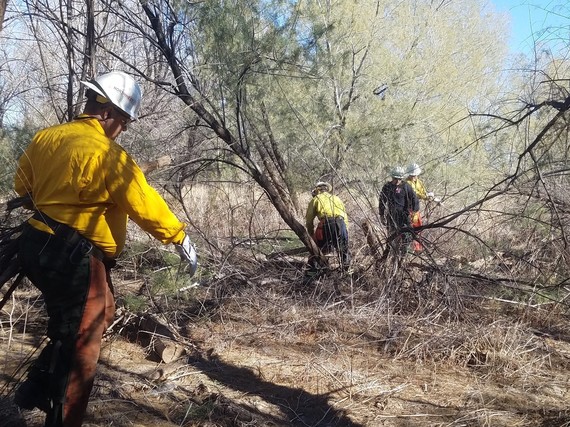 Tucson Audubon Society removes invasive trees in the Santa Cruz River
PIMA COUNTY – Pima County Regional Flood Control District (District) and Tucson’s Northwest Fire District are partnering with Tucson Audubon Society to prevent fires and restore native Sonoran Desert habitat.
This week the Tucson Audubon Society will be removing salt cedar trees and other invasive species from the Santa Cruz River channel west of the river’s confluence with the Cañada del Oro Wash. Using chain saws and other tools to cut the trees, workers will also be driving vehicles in the river bed to remove invasive vegetation.
Removing the fire-prone invasive plant species, and introducing the firebreaks, is just the first stage of the District’s larger initiative to restore the native riparian ecosystem with enhanced floodplain function. Native trees will support a great variety of wildlife and be available for human enjoyment and recreation.
Tucson Audubon Society workers will remove invasive species from El Corazón -- the heart of Tucson’s rivers, at the confluence of the Santa Cruz River, Rillito River, and the Cañada del Oro Wash. While greatly reducing fire danger to surrounding commercial and residential development, the project will also launch the process of restoring degraded land to prime waterway habitat for birds and other wildlife. Tucson Audubon’s mission to protect the birds of Southeast Arizona also protects and supports the people who live here.
Jennifer Becker, Principal Hydrologist at the District says, “We are happy to work with Tucson Audubon on this long-term project. They remove the fire danger, and plant native species in the flood plain. Native plants thrive and native bird and other animal species return. This desert habitat also provides a more authentic recreational experience along the Santa Cruz River corridor.”
Tucson Audubon Director of Conservation and Research, Jonathan Horst, describes the project as a great example of “[h]ow Tucson Audubon’s work to protect birds is in fact protecting the integrity of the Sonoran Desert ecosystem itself, as well as the safety and well-being of the people who have made their home here.”
|